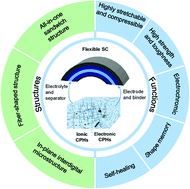Design and fabrication of conductive polymer hydrogels and their applications in flexible supercapacitors
Abstract
In recent years, as an energy storage device with a fast charge and discharge speed, long cycle life, and good stability, flexible supercapacitors (SCs) have been extensively used in flexible electronic devices such as smart textiles, flexible display screens, and micro-robots. Combining the advantages of conductive materials and hydrogels, conductive polymer hydrogels have good flexibility, biocompatibility, and adjustable mechanical and electrochemical properties, which enable them to be used as electrolyte or electrode materials for flexible SCs, endowing flexible SCs with various excellent properties and meeting their various working requirements. This paper comprehensively reviews the flexible SCs based on conductive polymer hydrogels, from the design, synthesis and application aspects of conductive polymer hydrogels, the various superior functions (e.g., self-healing, high stretchability and compressibility, high toughness, electrochromic and shape memory) of flexible SCs based on conductive polymer hydrogels to different structures of flexible SCs, including fiber-shaped structures, all-in-one sandwich structures, and in-plane interdigital microstructures. Finally, we summarize the challenges faced by flexible SCs based on conductive polymer hydrogels, which provides new research directions and prospects for future development in this field.

- This article is part of the themed collections: Journal of Materials Chemistry A Recent Review Articles and Journal of Materials Chemistry A HOT Papers


 Please wait while we load your content...
Please wait while we load your content...